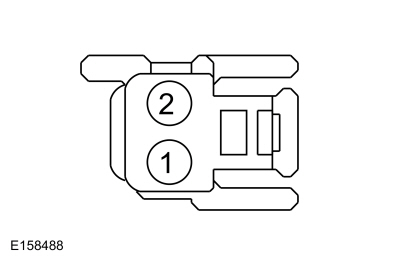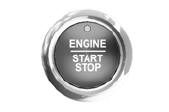Ford Escape: Engine Cooling / General Procedures - Engine Cooling System Draining, Vacuum Filling and Bleeding
Special Tool(s) / General Equipment
.jpg) |
ROB75240 Coolant/Battery Refractometer (Fahrenheit) |
| Fluid Container | |
| Cooling System Vacuum Tester and Refiller | |
Draining
NOTICE: The coolant must be recovered in a suitable, clean container for reuse. If the coolant is contaminated, it must be recycled or disposed of correctly. Using contaminated coolant may result in damage to the engine or cooling system components.
NOTICE: Use the correct coolant. Do not mix coolant types. Mixing coolant types may degrade the coolant corrosion protection and may damage the engine or cooling system. For the correct coolant specified for this vehicle, refer to Specifications.
NOTICE: Always fill the cooling system with the manufacturer's specified coolant. Chemically flush the cooling system if a non-specified coolant has been used. Refer to Cooling System Flushing. Failure to follow these instructions may damage the engine or cooling system.
NOTE: During normal vehicle operation, coolant can change color. As long as the engine coolant is clear and uncontaminated, this color change does not indicate the engine coolant has degraded nor does it require the engine coolant to be drained, the system to be flushed, or the engine coolant to be replaced.
NOTE: Less than 80% of coolant capacity can be recovered with the engine in the vehicle. Dirty, rusty or contaminated coolant requires replacement.
-
.jpg)
.jpg)
Remove the pressure relief cap..jpg) WARNING:
When releasing the cooling system pressure, cover the coolant expansion tank cap with a thick cloth.
WARNING:
When releasing the cooling system pressure, cover the coolant expansion tank cap with a thick cloth.
.jpg) |
-
With the vehicle in NEUTRAL, position it on a hoist.
Refer to: Jacking and Lifting - Overview (100-02 Jacking and Lifting, Description and Operation).
-
Remove the retainers and the underbody shield.
 |
-
.jpg)
.jpg) WARNING:
Be prepared to collect escaping fluid.
WARNING:
Be prepared to collect escaping fluid.
-
Use a hose to drain the coolant.
-
Open the radiator drain valve and drain the engine coolant in a suitable, clean container.
Use the General Equipment: Fluid Container
-
Use a hose to drain the coolant.
 |
Filling
Filling and Bleeding with a Vacuum Cooling System Filler
-
-
NOTICE: Use the correct coolant. Do not mix coolant types. Mixing coolant types may degrade the coolant corrosion protection and may damage the engine or cooling system. For the correct coolant specified for this vehicle, refer to Specifications.
NOTICE: Engine coolant provides boil protection, corrosion protection, freeze protection and cooling efficiency to the engine and cooling components. In order to obtain these protections, maintain the engine coolant at the correct concentration and fluid level in the degas bottle.
NOTICE: Do not add alcohol, methanol, or brine, or any engine coolants mixed with alcohol or methanol antifreeze. These can cause engine damage from overheating or freezing.
NOTE: Ford Motor Company does NOT recommend the use of recycled engine coolant since a Ford- approved recycling process is not yet available.
When adding or topping off the engine coolant:
-
Measure the coolant concentration in the vehicle.
Use Special Service Tool: ROB75240 Coolant/Battery Refractometer (Fahrenheit).
-
Determine the concentration desired based on the
vehicle duty cycle of extreme hot or cold operating conditions.
-
Add, top-off or adjust the coolant as follows:
Refer to: Specifications (303-03C Engine Cooling, Specifications).
-
-
Close the radiator drain valve.
.jpg) |
-
Install the engine underbody shield and the retainers.
 |
-
Install the vacuum cooling system filler and follow
the manufacturer's instructions to fill the cooling system.
Refer to: Specifications (303-03C Engine Cooling, Specifications).
Use the General Equipment: Cooling System Vacuum Tester and Refiller
-
Fill the degas bottle to the MAX FILL line.
-
Install the degas bottle cap until it contacts the hard stop.
-
Switch the ignition to RUN.
-
Put the transmission in PARK.
-
Turn the climate control system off.
-
Enter the cooling system fill mode.
-
Press the brake pedal for 10 seconds, release.
-
Press the brake pedal for 10 seconds, release.
-
Press the accelerator pedal to 100% for 10 seconds.
-
Press the brake pedal for 10 seconds, release.
-
Hold the accelerator pedal to 100% for 1 minute. The
coolant pump will operate at 100% and the engine will operate at 2,000
rpm.
-
Check the coolant level and fill to the MAX line on
the degas bottle. Check if the thermostat is open. If the thermostat is
open, the lower radiator hose will be hot.
-
Hold the accelerator pedal to 100% for 5 minutes.
The coolant pump will operate at 100% and the engine will operate at
2,000 rpm.
-
Check the coolant level and fill to the MAX line on
the degas bottle. Check if the thermostat is open. If the thermostat is
open, the lower radiator hose will be hot.
-
Repeat steps 13 and 14 until the thermostat is open
-
Hold the accelerator pedal to 100% for 1 minute. The
coolant pump will operate at 100% and the engine will operate at 2,000
rpm.
-
Check the engine coolant level in degas bottle and if necessary fill to the top of the MAX FILL line on the degas bottle..jpg) WARNING:
Always allow the engine to cool before opening
the cooling system. Do not unscrew the coolant pressure relief cap when
the engine is operating or the cooling system is hot. The cooling system
is under pressure; steam and hot liquid can come out forcefully when
the cap is loosened slightly. Failure to follow these instructions may
result in serious personal injury.
WARNING:
Always allow the engine to cool before opening
the cooling system. Do not unscrew the coolant pressure relief cap when
the engine is operating or the cooling system is hot. The cooling system
is under pressure; steam and hot liquid can come out forcefully when
the cap is loosened slightly. Failure to follow these instructions may
result in serious personal injury.
-
Install the pressure relief cap.
.jpg) |
Filling and Bleeding without a Vacuum Cooling System Filler
-
-
NOTICE: Use the correct coolant. Do not mix coolant types. Mixing coolant types may degrade the coolant corrosion protection and may damage the engine or cooling system. For the correct coolant specified for this vehicle, refer to Specifications.
NOTICE: Engine coolant provides boil protection, corrosion protection, freeze protection and cooling efficiency to the engine and cooling components. In order to obtain these protections, maintain the engine coolant at the correct concentration and fluid level in the degas bottle.
NOTICE: Do not add alcohol, methanol, or brine, or any engine coolants mixed with alcohol or methanol antifreeze. These can cause engine damage from overheating or freezing.
NOTE: Ford Motor Company does NOT recommend the use of recycled engine coolant since a Ford- approved recycling process is not yet available.
When adding or topping off the engine coolant:
-
Measure the coolant concentration in the vehicle.
Use Special Service Tool: ROB75240 Coolant/Battery Refractometer (Fahrenheit).
-
Determine the concentration desired based on the
vehicle duty cycle of extreme hot or cold operating conditions.
-
Add, top-off or adjust the coolant as follows:
Refer to: Specifications (303-03C Engine Cooling, Specifications).
-
-
Close the radiator drain valve.
.jpg) |
-
Fill the degas bottle until engine coolant flows from the heater inlet tube.
-
Install the engine underbody shield and the retainers.
 |
-
Fill the degas bottle to the MAX FILL line.
-
Install the degas bottle cap until it contacts the hard stop.
-
Switch the ignition to RUN.
-
Put the transmission in PARK.
-
Turn the climate control system off.
-
Enter the cooling system fill mode.
-
Press the brake pedal for 10 seconds, release.
-
Press the brake pedal for 10 seconds, release.
-
Press the accelerator pedal to 100% for 10 seconds.
-
Press the brake pedal for 10 seconds, release.
-
Hold the accelerator pedal to 100% for 1 minute. The
coolant pump will operate at 100% and the engine will operate at 2,000
rpm.
-
Check the coolant level and fill to the MAX line on
the degas bottle. Check if the thermostat is open. If the thermostat is
open, the lower radiator hose will be hot.
-
Hold the accelerator pedal to 100% for 5 minutes.
The coolant pump will operate at 100% and the engine will operate at
2,000 rpm.
-
Check the coolant level and fill to the MAX line on
the degas bottle. Check if the thermostat is open. If the thermostat is
open, the lower radiator hose will be hot.
-
Repeat steps 31 and 32 until the thermostat is open
-
Hold the accelerator pedal to 100% for 1 minute. The
coolant pump will operate at 100% and the engine will operate at 2,000
rpm.
-
Check the engine coolant level in degas bottle and if necessary fill to the top of the MAX FILL line on the degas bottle..jpg) WARNING:
Always allow the engine to cool before opening
the cooling system. Do not unscrew the coolant pressure relief cap when
the engine is operating or the cooling system is hot. The cooling system
is under pressure; steam and hot liquid can come out forcefully when
the cap is loosened slightly. Failure to follow these instructions may
result in serious personal injury.
WARNING:
Always allow the engine to cool before opening
the cooling system. Do not unscrew the coolant pressure relief cap when
the engine is operating or the cooling system is hot. The cooling system
is under pressure; steam and hot liquid can come out forcefully when
the cap is loosened slightly. Failure to follow these instructions may
result in serious personal injury.
-
Install the pressure relief cap.
.jpg) |
 Diagnosis and Testing - Engine Temperature
Diagnosis and Testing - Engine Temperature
Diagnostic Trouble Code (DTC) Chart
Diagnostics in this manual assume a certain skill level and knowledge of Ford-specific diagnostic practices. REFER to: Diagnostic Methods (100-00 General Information, Description and Operation)...
 General Procedures - Engine Cooling System Flushing
General Procedures - Engine Cooling System Flushing
Flushing
WARNING:
Always allow the engine to cool before opening the cooling
system. Do not unscrew the coolant pressure relief cap when the engine
is operating or the cooling system is hot...
Other information:
Ford Escape 2020-2025 Service Manual: Removal and Installation - Back Panel and Reinforcement
Special Tool(s) / General Equipment Resistance Spotwelding Equipment Scraper for Straight Edges Hot Air Gun 8 mm Drill Bit MIG/MAG Welding Equipment Spot Weld Drill Bit Locking Pliers Materials Name Specification Metal Bonding AdhesiveTA-1, TA-1-B, 3M™ 08115, LORD Fusor® 108B, Henkel Teroson EP 5055 - Seam SealerTA-2-B, 3M™ 08308, ..
Ford Escape 2020-2025 Service Manual: Removal and Installation - Cowl Panel Grille
Removal NOTE: Removal steps in this procedure may contain installation details. Remove the windshield wiper pivot arm. Refer to: Windshield Wiper Pivot Arm (501-16 Wipers and Washers, Removal and Installation). Remove the clips. Pull outward to release the locking clips and position the upper portion of the cowl panel grille away fro..
Categories
- Manuals Home
- 4th Generation Ford Escape Owners Manual
- 4th Generation Ford Escape Service Manual
- Switching the Rear Window Wiper On and Off. Reverse Wipe
- Switching the Lane Keeping System On and Off. Switching the Lane Keeping System Mode. Alert Mode
- Locating the Pre-Collision Assist Sensors
- New on site
- Most important about car
Push Button Ignition Switch

Switching the Ignition Off
When the ignition is on or in accessory mode, press the push button ignition switch once without your foot on the brake pedal.
